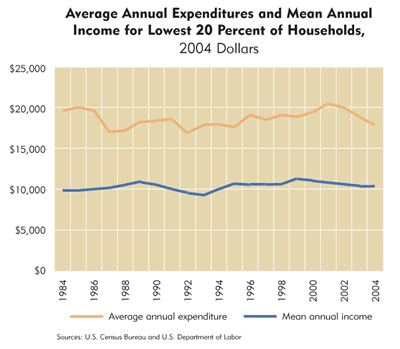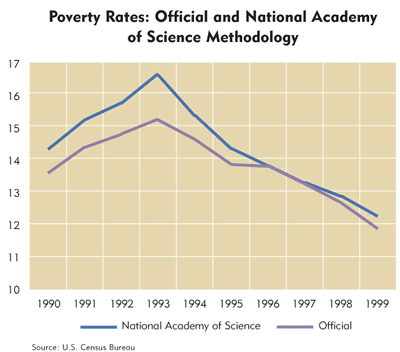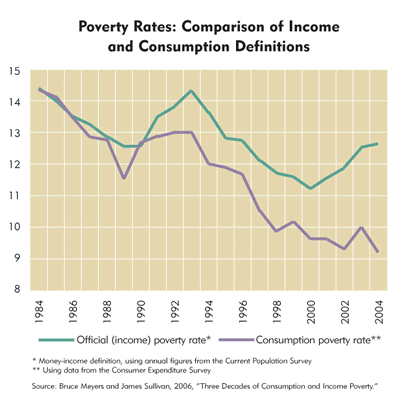On its face, poverty seems to be a pretty straightforward concept.
Based on household income and estimates of need, official federal guidelines draw a line in the sand. Below the line, poor; above the line, not. Most understand that the line is not black and white in terms of well-being—that being one dollar over the poverty line isn't the difference between hardship and the good life.
Official poverty guidelines were first developed in 1963 by economist Mollie Orshansky (working at the Social Security Administration) and formally adopted two years later as the measuring stick for President Lyndon Johnson's War on Poverty. Although changes have been made, in essence today's poverty yardstick still reflects Orshansky's original definition of poverty based mostly on household food consumption and minimally adequate diets.
Most economists, sociologists and other researchers agree that this definition—called the "money-income" approach by researchers—is far too simplistic a measure for such an important, multifaceted phenomenon as poverty. A slew of studies point out problems with how we define the two sides of the current poverty equation: first, basic household "needs" and second, the income necessary to meet those needs. Numerous alternative methodologies have been drawn up to cover methodological holes. Many studies indicate that poverty is higher than official estimates; others say it's lower.
A growing body of research says that the money-income definition of poverty is misguided to begin with and argues that a better, more direct way to assess household need and hardship is to look at consumption rather than income. Unlike most alternative measures of poverty, which tend to mirror the overall trend pattern of the official measure, consumption-based research suggests that poverty has lessened.
Income calculator on the fritz
First, a quick word about the shortcomings of the official poverty measure. Simply stated, it fails to rigorously measure either household need or income.
From the standpoint of need, the official poverty measure includes no consideration for such basic necessities as housing and health care, both of whose costs have been rising. Neither does it factor in certain work-based expenses like day care and transportation that can consume a disproportionately large bite of the household budget, leaving less for immediate necessities. On the flip side, the current definition also grossly overstates the necessary food budget, given that the cost of food has been going down when adjusted for inflation and makes up a much smaller percentage of a household budget today than in the 1960s.
When it comes to income, the current measure might be generously described as partial; crude is probably more accurate. For example, poverty income thresholds do not capture government efforts to support poor households, including near-cash transfer programs (like food stamps and housing subsidies) or direct-cash programs like the Earned Income Credit, each of which can add thousands of dollars to annual family income and technically push many out of poverty. The EIC, for example, offers cash incentives of up to $4,400 to low-wage workers with children. Last year, the program distributed $40 billion to low-income families—significantly more than the cash assistance given through the nation's traditional welfare program, Temporary Aid for Needy Families. Although the EIC lifts millions of people above the poverty line every year, all of them are nonetheless officially counted as poor.
Existing income measures also fail to gauge private transfers—informal contributions, personal loans, gifts or cost-sharing efforts a household might undertake to help make ends meet. In a 2005 working paper for the National Bureau of Economic Research (NBER), Steven Haider and Kathleen McGarry note that private transfers receive little attention, but "are an important source of income for many less-skilled households" and appear to be increasing, in part because more unmarried adults are living together.
Researchers have long acknowledged these and other shortcomings of the official poverty measure. In a 1999 paper on the politics of poverty measurement, Gary Burtless of the Brookings Institute wrote, "The Census Bureau continues to publish an official estimate that all informed observers, regardless of political preference, agree is seriously flawed."
Not even the Census Bureau will stump for the existing measure. Chuck Nelson, assistant division chief for income, poverty and health statistics for the Census Bureau, pointed out that the agency has no vested interest in the matter: Technically, the current definition was adopted, and must be changed, by the Office of Management and Budget. "Census just collects the data," Nelson said.
Dissatisfaction with the current poverty measure has spurred a cottage industry in alternative measures—some that define basic needs differently, others that measure income more comprehensively, others doing both. "In the research community, there's been a lot of excitement" about the potential of better poverty measures," said Nelson.
Not surprisingly, poverty rates calculated by these alternative methods tend to deviate from official levels. Those that adjust for different types of expenditures (like health care and work and child-care expenses, all of which lower discretionary income) generally show higher poverty rates. Other studies that adjust for a more sophisticated definition of income typically (but not always) show a lower poverty rate (see chart). One notable finding: Many alternative methodologies, particularly those that tinker with income definitions, produce a poverty pattern that follows the general path of the official measure fairly closely over the past 20 years or so.

A 1995 report by the National Academy of Sciences was widely believed to have developed more rigorous income and basic-need thresholds that resulted in higher poverty rates than the official measure (see chart). But NAS recommendations were never implemented. "I've not noted any serious effort (by policymakers) to really change the official measure," Nelson said.

That's reportedly because many parties have a major stake in the existing definition; small changes can mean big swings in who is and is not considered poor, all of which is tied to tens of billions of dollars in public spending. This brings a multitude of interest groups—both political and nonpolitical—to the lawmaking table, many of them pulling in opposite directions.
You are what you buy
There's an even more fundamental problem with an income-based poverty measure. It can't gauge what society is most concerned about: namely, deprivation and unmet basic needs. In other words, if we're worried about families' ability to obtain the necessities of life—food, clothing, shelter, health care—then income is a mere proxy for that; we can only assume that with a certain amount of money those needs get met.
Many believe consumption- or expenditure-based measures offer a truer gauge of poverty, because measuring consumption gets closer to the matter of whether families do satisfy their basic needs. In a 2004 study, David Johnson of the Bureau of Labor Statistics (BLS) noted that a consumption approach can be more useful because "families and individuals derive material well-being from the actual consumption of goods and services rather than from the receipt of income per se; hence, it is appropriate to estimate their consumption directly."
Yes, income is important, but it overlooks alternative financial resources—government assistance, private transfers—as well as tight budgeting and other thrift efforts that families use to make ends meet. The utility of a consumption approach becomes more obvious when we see that poor families regularly consume more—sometimes much more—in terms of food and material and nonmaterial goods than their income would suggest is possible.
For example, households earning between $5,000 and $10,000 a year spend an average of $14,500, according to the Census' annual Consumer Expenditure Survey, one of the major sources of consumer spending data. Over the past two decades, household income and consumer expenditures for the bottom 20 percent of households show a wide and consistent gap: Since 1984, expenditures have typically run 70 percent to 100 percent over annual income (see chart). This has happened while household size has also declined over time.
How can this be? There are several possible explanations. As has been pointed out, income measures leave a lot to be desired; both wage and nonwage resources are likely underreported, and considerable government assistance is not included. Households might also be spending beyond their means, tapping home equity, credit cards or other resources.
Wherever the resources come from, we know that the comfort level and living standards for poor households have been improving. Notwithstanding widespread anecdotes about greater demand at local food shelves since the last recession, the percentage of households with children that report reduced food intake and disrupted eating patterns ("food insecurity with hunger," as defined by the U.S. Department of Agriculture) has been below 1 percent for the past seven years, including through the recession. This is due, in part, to government programs targeting those most at risk for hunger—like free and reduced-price school lunches for children, not to mention an increasing number of breakfast and weekend food programs for school-age kids. These financial resources aren't counted in household income statistics.
Rising consumption is also apparent in the material possessions of low-income households. A 2005 report by the Census showed that among households ranked in the bottom 10 percent by expenditure, the percentage with microwaves almost doubled to 77 percent from 1992 to 2002; washers went up from 45 to 54 percent; dryers from 30 to 47 percent; computers from 4 to 21 percent; and videocassette recorders up to 56 percent. As of 2002, 92 percent had color televisions, and the average household in the bottom decile owned 1.3 of them. Other reports universally show the same consumption trend: Poor households own more stuff and utilize more services than ever before.
Not foolproof
Add it all up, and a different pattern emerges regarding poverty. A 2003 Census report on material well-being noted, "As many (studies) show, the levels of poverty and inequality tend to decrease using consumption-based figures, in comparison with income-based measures."
Recent studies have reinforced that notion. In a 2006 working paper for the NBER, economists Bruce Meyer (University of Chicago) and James Sullivan (Notre Dame) pointed out that the official poverty rate "suggests that poverty has changed very little over the past three decades," rising with recessions and then subsequently falling. In contrast, "Consumption-based poverty rates often indicate large declines, even in recent years when income-based poverty rates have risen" (see chart).

Responding to questions via e-mail, Sullivan said that consumption "is a more consistent measuring stick over time and that it is a better measure of the well-being of the worse off." He added, "Over the past three decades, consumption poverty tells a more optimistic story than does income poverty ... suggesting we are winning the war on poverty."
Some economists prefer to look at consumption because it is less volatile than income on an annual basis for most households. People smooth their consumption based on long-term income expectations. Such a phenomenon is readily apparent among those who lose a job. While their income might plummet, consumption tends to fall much less dramatically. Such households tend to either dip into savings or take on additional debt with the expectation that higher income will return in due time.
All this is not to say that consumption wins the best-measuring-stick debate hands down, even among advocates. Sullivan, for example, acknowledged "some important practical concerns with switching to consumption," including the fact that consumption surveys are much smaller in scale than income surveys, making it difficult to analyze local patterns because of sampling problems.
The consumption model has other blind spots. For example, it can only measure total costs; it has no ability to distinguish the quality of purchases or the utility of different types of purchases to a household. For example, a 2005 working paper by Thomas Deleire of Michigan State and Helen Levy of the University of Michigan found that higher expenditures among single-mother households during the 1990s "can be explained by a shift from food at home to food away from home." While that is positive in some senses—less work cooking at home and more food "leisure"—an alternative explanation is that more meals were eaten outside the home out of necessity and at higher cost to the household budget, as more single mothers worked, either voluntarily or because of changes to the welfare system in the 1990s. Better off? Hard to say for sure.
Sullivan and others also point out that income poverty has simple longevity on its side. "I think it is well understood that there are flaws in the official measure of poverty," Sullivan said. "(But) we have been using the current measure for about 40 years, so we have a nice time series that is generally understood." A 2005 article in the BLS's Monthly Labor Review noted that most studies of well-being are based on income data "partly because of history and also partly because of habit. Income data are accessible, comparable over time, and of high quality." International comparisons are possible only through income because other measures like consumption are simply unavailable in most other countries.
Austin Nichols, a research associate at the Urban Institute, a nonpartisan economic and social policy research organization, has authored several recent reports on poverty trends. "I think a lot of folks use the official poverty line for the sake of convenience and comparability," Nichols said via e-mail. That might sound like faint praise, but Nichols said that "convenience and comparability is not to be scoffed at." Any new measure would not likely offer a view of poverty dating back to the 1960s and could have "equivalent or greater problems. ... At least the official poverty measure is understood by most people, as are some of its limitations."
In the end, everything is relative. Not even researchers within the same organization agree on the best way to measure poverty. Gregory Acs is a senior research associate at the Urban Institute. Along with his counterpart Nichols, he has considerable experience with both poverty trends and the definition-measurement issue.
Acs and Austin tend to disagree over the utility of consumption-based poverty measures. According to Acs, "Ultimately, consumption is a better measure of well-being than income, but I think it is harder to measure, and income is not a bad proxy for consumption." But Nichols responded, "I disagree that consumption is a better measure of well-being," in part because researchers don't know how much consumption is financed by unsustainable borrowing. He added that consumption measures "have just as many problems as income-based measures."
This scholarly head butting illustrates the general difficulty of pinning down who is poor and who is not. Said Acs, "I think Austin and I agree that there are pros and cons to all the poverty approaches," both income and consumption.
The existing measure has stuck because "we have the most experience measuring income ... (and) researchers and policymakers are by now quite aware of its limitations," according to Acs. "We want poverty to be an absolute measure of deprivation, and I think that's asking too much of any single statistic."
Ron Wirtz is a Minneapolis Fed regional outreach director. Ron tracks current business conditions, with a focus on employment and wages, construction, real estate, consumer spending, and tourism. In this role, he networks with businesses in the Bank’s six-state region and gives frequent speeches on economic conditions. Follow him on Twitter @RonWirtz.





